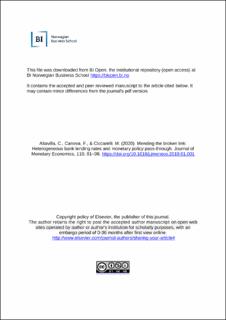| dc.contributor.author | Altavilla, Carlo | |
| dc.contributor.author | Canova, Fabio | |
| dc.contributor.author | Ciccarelli, Matteo | |
| dc.date.accessioned | 2020-06-12T07:49:28Z | |
| dc.date.available | 2020-06-12T07:49:28Z | |
| dc.date.created | 2019-05-13T10:11:47Z | |
| dc.date.issued | 2019 | |
| dc.identifier.citation | Journal of Monetary Economics. 2020, 110 (April) 81-98. | en_US |
| dc.identifier.issn | 0304-3932 | |
| dc.identifier.uri | https://hdl.handle.net/11250/2657820 | |
| dc.description.abstract | We analyse the pass-through of monetary policy measures to lending rates to households and firms in the euro area using novel bank-level datasets. Banks’ characteristics such as the capital ratio, exposure to domestic sovereign debt, percentage of non-performing loans and stability of funding structure are responsible for the heterogeneity in the pass-through of conventional monetary policy changes. The location of a bank is irrelevant. Non-standard measures reduce lending rate heterogeneities. Banks located in financially stressed countries and with weak balance sheets are most affected. Banks’ lending margins have fallen considerably. | en_US |
| dc.language.iso | eng | en_US |
| dc.publisher | Elsevier | en_US |
| dc.rights | Attribution-NonCommercial-NoDerivatives 4.0 Internasjonal | * |
| dc.rights.uri | http://creativecommons.org/licenses/by-nc-nd/4.0/deed.no | * |
| dc.title | Mending the broken link: Heterogeneous bank lending rates and monetary policy pass-through | en_US |
| dc.type | Journal article | en_US |
| dc.type | Peer reviewed | en_US |
| dc.description.version | acceptedVersion | en_US |
| dc.source.pagenumber | 81-98 | en_US |
| dc.source.volume | 110 | en_US |
| dc.source.journal | Journal of Monetary Economics | en_US |
| dc.source.issue | April | en_US |
| dc.identifier.doi | 10.1016/j.jmoneco.2019.01.001 | |
| dc.identifier.cristin | 1697306 | |
| cristin.ispublished | true | |
| cristin.fulltext | postprint | |
| cristin.qualitycode | 2 | |

